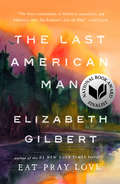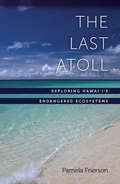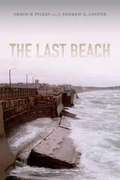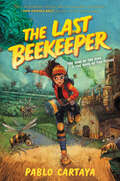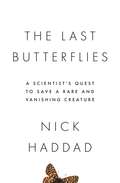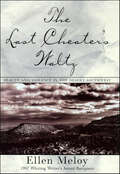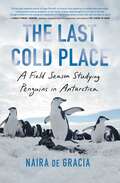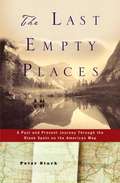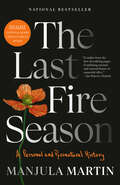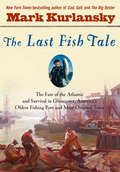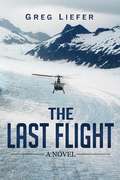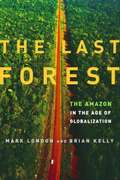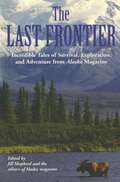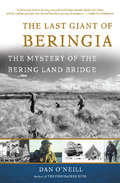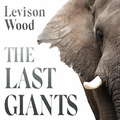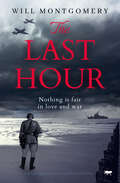- Table View
- List View
The Last American Man
by Elizabeth Gilbert<P>In this rousing examination of contemporary American male identity, acclaimed author and journalist Elizabeth Gilbert explores the fascinating true story of Eustace Conway. <P>In 1977, at the age of seventeen, Conway left his family's comfortable suburban home to move to the Appalachian Mountains. <P>For more than two decades he has lived there, making fire with sticks, wearing skins from animals he has trapped, and trying to convince Americans to give up their materialistic lifestyles and return with him back to nature. <P>To Gilbert, Conway's mythical character challenges all our assumptions about what it is to be a modern man in America; he is a symbol of much we feel how our men should be, but rarely are. <P><b>Finalist for the National Book Award 2002</b>
The Last Atoll
by Pamela FriersonThe Last Atoll is a first-person account of journalist Pamela Frierson's ten-year exploration of the exotic and ecologically significant small lands at the far northwestern end of the Hawaiian island chain. Frierson takes readers on a rare journey to eight of these remote and ancient islands, including the Kure Atoll, the oldest Hawa'i'ian island and the northernmost atoll in the world. In her 1,200-mile travels, Frierson discovers isolated landscapes, undisturbed ecosystems, and a nearly forgotten but well-preserved human history. It is a rich history of discovery by explorers and pirates, plus extensive military use. Frierson finds a vast wilderness, including the remnants of ancient volcanoes, and unique species of wildlife. She also explores the islands' location in the Great Pacific Garbage Patch, a major current that washes up the world's garbage. A lifelong resident of Hawai'i, Frierson draws broad conclusions relating to islands and their "canary in a coal mine" role.
The Last Atoll
by Pamela FriersonThe Last Atoll is a first-person account of journalist Pamela Frierson's ten-year exploration of the exotic and ecologically significant small lands at the far northwestern end of the Hawaiian island chain. Frierson takes readers on a rare journey to eight of these remote and ancient islands, including the Kure Atoll, the oldest Hawa'i'ian island and the northernmost atoll in the world. In her 1,200-mile travels, Frierson discovers isolated landscapes, undisturbed ecosystems, and a nearly forgotten but well-preserved human history. It is a rich history of discovery by explorers and pirates, plus extensive military use. Frierson finds a vast wilderness, including the remnants of ancient volcanoes, and unique species of wildlife. She also explores the islands' location in the Great Pacific Garbage Patch, a major current that washes up the world's garbage. A lifelong resident of Hawai'i, Frierson draws broad conclusions relating to islands and their "canary in a coal mine" role.
The Last Beach
by Orrin H. Pilkey Jr. J. Andrew CooperThe Last Beach is an urgent call to save the world's beaches while there is still time. The geologists Orrin H. Pilkey and J. Andrew G. Cooper sound the alarm in this frank assessment of our current relationship with beaches and their grim future if we do not change the way we understand and treat our irreplaceable shores. Combining case studies and anecdotes from around the world, they argue that many of the world's developed beaches, including some in Florida and in Spain, are virtually doomed and that we must act immediately to save imperiled beaches.After explaining beaches as dynamic ecosystems, Pilkey and Cooper assess the harm done by dense oceanfront development accompanied by the construction of massive seawalls to protect new buildings from a shoreline that encroaches as sea levels rise. They discuss the toll taken by sand mining, trash that washes up on beaches, and pollution, which has contaminated not only the water but also, surprisingly, the sand. Acknowledging the challenge of reconciling our actions with our love of beaches, the geologists offer suggestions for reversing course, insisting that given the space, beaches can take care of themselves and provide us with multiple benefits.
The Last Beekeeper
by Pablo CartayaFacing a world dually altered by climate change and those who profit from it, Yolanda Cicerón will have to fight to save the last known beehive from extinction in this stirring new adventure by award-winning author Pablo Cartaya.In a future shaken by climate disasters, Yolanda Cicerón knows that nature is something to be feared. While life in the Valley is brutal and harsh, Yoly dreams of leaving her farm to live in Silo—the most advanced town for miles around. But first, Yoly will need to prove she belongs in a place where only the smartest and most useful are welcomed. Between her razor-sharp smarts and sheer determination, Yoly is well on her way until she discovers her family can no longer afford her schooling. When forced to take matters into her own hands, the closer she gets to securing her future, the more she uncovers the dangers lying inside Silo’s walls—ones that threaten the entire Valley. As she cracks long-guarded secrets, Yoly, along with those closest to her, is put in grave peril and the only chance of surviving may lie in the rediscovery of a long-extinct species—the honeybee. Can the last surviving beehive be the key to pulling the Valley out from under Silo’s thumb, or will they destroy what remains of Yoly’s future?
The Last Butterflies: A Scientist's Quest to Save a Rare and Vanishing Creature
by Nick HaddadA remarkable look at the rarest butterflies, how global changes threaten their existence, and how we can bring them back from near-extinctionMost of us have heard of such popular butterflies as the Monarch or Painted Lady. But what about the Fender’s Blue? Or the St. Francis’ Satyr? Because of their extreme rarity, these butterflies are not well-known, yet they are remarkable species with important lessons to teach us. The Last Butterflies spotlights the rarest of these creatures—some numbering no more than what can be held in one hand. Drawing from his own first-hand experiences, Nick Haddad explores the challenges of tracking these vanishing butterflies, why they are disappearing, and why they are worth saving. He also provides startling insights into the effects of human activity and environmental change on the planet’s biodiversity.Weaving a vivid and personal narrative with ideas from ecology and conservation, Haddad illustrates the race against time to reverse the decline of six butterfly species. Many scientists mistakenly assume we fully understand butterflies’ natural histories. Yet, as with the Large Blue in England, we too often know too little and the conservation consequences are dire. Haddad argues that a hands-off approach is not effective and that in many instances, like for the Fender’s Blue and Bay Checkerspot, active and aggressive management is necessary. With deliberate conservation, rare butterflies can coexist with people, inhabit urban fringes, and, in the case of the St. Francis’ Satyr, even reside on bomb ranges and military land. Haddad shows that through the efforts to protect and restore butterflies, we might learn how to successfully confront conservation issues for all animals and plants.A moving account of extinction, recovery, and hope, The Last Butterflies demonstrates the great value of these beautiful insects to science, conservation, and people.
The Last Cheater's Waltz: Beauty and Violence in the Desert Southwest
by Ellen MeloyFrom the recipient of the 1997 Whiting Award.Feeling disconnected from the wildly beautiful desert that she has known intimately for twenty years, award-winning writer Ellen Meloy embarks on a search for home that is historical, scientific, and spiritual. Her "Map of the Known Universe," devised to guide her quest, reveals extraordinary details of a physical link between the atomic age and her home on Utah's San Juan River. The Map grows to include Los Alamos, the Trinity A-test site, White Sands Missile Range, and primary sources of uranium.Meloy casts her naturalist's eye on the Southwest's "geography of consequence," where she finds unusual local bestiaries, the bodies of long-buried neighbors, an underground bubble of nuclear physics in a national forest, and the rich textures of nature on her own eight acres of land. The Last Cheater's Waltz: Beauty and Violence in the Desert Southwest is multilayered and far-reaching, yet always infused with Meloy's prodigious research, finely tuned prose, and wry humor.
The Last Cold Place: A Field Season Studying Penguins in Antarctica
by Naira de GraciaLab Girl meets Why Fish Don&’t Exist in this brilliant, fascinating memoir about a young scientist&’s experience studying penguins in Antarctica—a firsthand account of the beauty and brutality of this remote climate, the direct effects of climate change on animals, and the challenges of fieldwork.Naira de Gracia&’s The Last Cold Place offers a dramatic, captivating window into a once-in-a-lifetime experience: a season living and working in a remote outpost in Antarctica alongside seals, penguins, and a small crew of fellow field workers. In one of the most inhospitable environments in the world (for humans, anyway), Naira follows a generation of chinstrap penguins from their parents&’ return to shore to build nests from pebbles until the chicks themselves are old enough to head out to sea. In lively and entertaining anecdotes, Naira describes the life cycle of a funny, engaging colony of chinstrap penguins whose food source (krill, or small crustaceans) is powerfully affected by the changing ocean. Weaving together the history of Antarctic exploration with climate science, field observations, and her own personal journey of growth and reflection, The Last Cold Place illuminates the complex place that Antarctica holds in our cultural imagination—and offers a rare glimpse into life on this uninhabited continent.
The Last Eagle
by Daniel MannixSurvival--against the hostility of man and beast, and against the dreadful odds of Nature--is the theme of this magnificent book, a beautifully written fictionalised biography. It tells the story, from timorous infancy to glorious maturity, of an American bald eagle. Daniel Mannix captures all the poetry, romance, and glory of an eagle's life, while telling his reader how it must feel to be a fledgling struggling for food, a young bird just learning to hunt, and finally what it must be like to reign as acknowledged lord of the skies. The eagle of which the author writes may well be the last; the bald eagles have been badly depleted by hunters, vandals, and egg collectors. THE LAST EAGLE is both a poignant and fascinating story and a plea for conservation.
The Last Empty Places: A Past and Present Journey through the Blank Spots on the American Map
by Peter StarkFor readers of both travel and history, Stark explores the blank spots on the U. S. map, weaving together riveting American history, a wonderful contemporary travelogue, and a deeply engaging examination of the history of wilderness.
The Last Fire Season: A Personal and Pyronatural History
by Manjula MartinH Is for Hawk meets Joan Didion in the Pyrocene in this arresting combination of memoir, natural history, and literary inquiry that chronicles one woman&’s experience of life in Northern California during the worst fire season on record.A MOST-ANTICIPATED BOOK: The New York Times, The Los Angeles Times, The San Francisco Chronicle, The Saturday Evening Post, Poets & Writers, The Millions, Alta, Heat Map NewsTold in luminous, perceptive prose, The Last Fire Season is a deeply incisive inquiry into what it really means—now—to live in relationship to the elements of the natural world. When Manjula Martin moved from the city to the woods of Northern California, she wanted to be closer to the wilderness that she had loved as a child. She was also seeking refuge from a health crisis that left her with chronic pain, and found a sense of healing through tending her garden beneath the redwoods of Sonoma County. But the landscape that Martin treasured was an ecosystem already in crisis. Wildfires fueled by climate change were growing bigger and more frequent: each autumn, her garden filled with smoke and ash, and the local firehouse siren wailed deep into the night.In 2020, when a dry lightning storm ignited hundreds of simultaneous wildfires across the West and kicked off the worst fire season on record, Martin, along with thousands of other Californians, evacuated her home in the midst of a pandemic. Both a love letter to the forests of the West and an interrogation of the colonialist practices that led to their current dilemma, The Last Fire Season, follows her from the oaky hills of Sonoma County to the redwood forests of coastal Santa Cruz, to the pines and peaks of the Sierra Nevada, as she seeks shelter, bears witness to the devastation, and tries to better understand fire&’s role in the ecology of the West. As Martin seeks a way to navigate the daily experience of living in a damaged body on a damaged planet, she comes to question her own assumptions about nature and the complicated connections between people and the land on which we live.
The Last Fish Tale: The Fate of the Atlantic and Our Disappearing Fisheries
by Mark KurlanskyWill most of the major fisheries of the world be exhausted by 2048, as has been claimed? Have the number of large fish in the ocean decreased by 90 per cent over the past 50 years, as has been asserted by a respected scientist? Are 60 per cent of the fish species studied by the United Nations Food and Agriculture Organisation either fully exploited or depleted, as one of their reports attests? Fishing at sea, an ancient trade and a way of life that has defined coastal towns throughout history, may be coming to an end. The culture and traditions of coastal Britain and of seagoing nations everywhere are now threatened with extinction. In his most important book yet, Mark Kurlansky - the celebrated author of Cod, Salt and The Big Oyster - explores the fate of our oceans and the decline of our most ancient coastal enterprise. The Last Fish Tale sends up a timely distress flare but one which brilliantly illuminates a colourful, exuberant and poignant landscape, from Newlyn in Cornwall to Gloucester in Massachusetts - a fishing village first settled by Englishmen in the early 1600s. The result is a cultural, economic, environmental and culinary bouillabaisse - the most compelling fish tale of our time.
The Last Flight of the Scarlet Macaw: One Woman's Fight to Save the World's Most Beautiful Bird
by Bruce BarcottCaring for orphaned animals at her own zoo in the tropical country of Belize, Sharon Matola became one of Central America's greatest wildlife defenders. And when powerful outside forces conspired with the local government to build a dam that would flood the nesting ground of the only scarlet macaws in Belize, Matola was drawn into the fight of her life. In The Last Flight of the Scarlet Macaw, award-winning author Bruce Barcott chronicles Sharon Matola's inspiring crusade to stop a multinational corporation in its tracks. Ferocious in her passion, Matila and her confederates--a ragtag army of courageous locals and eccentric expatriates--endure slander and reprisals and take the fight to the courtroom and the boardroom, from local village streets to protests around the globe. Barcott explores the tension between environmental conservation and human development, puts a human face on the battle over globalization, and ultimately shows us how one unwavering woman risked her life to save the most beautiful bird in the world.
The Last Flight: A Novel
by Gregory P. LieferSet against the harsh beauty of Alaska, a veteran helicopter pilot is torn between ending his own embattled life and rescuing survivors from a mountain plane crash.Last Flight is the heroic story of Gil Connor, a senior Army helicopter pilot and aging Vietnam vet, as he struggles with an impending terminal illness and the desire to pull off one last daring rescue. Connor finds himself in a constant battle against his internal demons during his quest to reach the survivors of a remote, civilian commuter-plane crash deep in the Alaskan mountains-a rescue that perhaps only he can pull off.The stranded plane’s captain, Scott Sanders, takes charge after the crash, in spite of his injuries and the realization that his dream of flying for a major airline is destroyed. One of the passengers, a retired school teacher, assists him while barely holding herself together; her husband was killed in a fiery plane crash years before. They soon realize that time is not on their side in the Alaskan polar climate.Connor, who’s haunted by the horrors of war and a turbulent past, is torn between ending his life before the inevitable and saving the marooned crash victims before it’s too late. His underlying intentions are unknown, even to himself, until the very end. Aided by an untested protégée and a mysterious young girl found at the crash site, Connor struggles in a desperate gamble to achieve the near impossible. Amid the turmoil of an approaching storm and almost certain failure, his flying skills and drive for redemption are the only hopes that remain.Skyhorse Publishing, as well as our Arcade, Yucca, and Good Books imprints, are proud to publish a broad range of books for readers interested in fiction-novels, novellas, political and medical thrillers, comedy, satire, historical fiction, romance, erotic and love stories, mystery, classic literature, folklore and mythology, literary classics including Shakespeare, Dumas, Wilde, Cather, and much more. While not every title we publish becomes a New York Times bestseller or a national bestseller, we are committed to books on subjects that are sometimes overlooked and to authors whose work might not otherwise find a home.
The Last Forest: The Amazon in the Age of Globalization
by Mark London Brian KellyWith a landmass larger than the continental U. S. west of the Mississippi and the richest diversity of plant and animal species on earth, the Amazon has always struck its explorers and would-be exploiters as infinite and largely impenetrable. For decades, anthropologists assumed that permanent human habitation was impossible–-but they were wrong. Recently, proof of centuries-old Amazonian civilizations has been unearthed, shifting perceptions of the inhospitability of the rain forest and providing a precedent for human occupation. Today, as developers and environmentalists clash over the region’s future, the seemingly endless forest is fast disappearing in fires, rampant mineral extraction, rogue logging operations, and encroaching urban sprawl. Through a series of startling human encounters–interviews with government ministers and environmental crusaders, millionaire ranchers and disenfranchised slum dwellers–Mark London and Brian Kelly, longtime explorers and trailblazing chroniclers of the Amazon basin, trace the region’s transformation. Logging thousands of miles, London and Kelly take readers from the mushrooming shopping malls of Manaus to the pristine rain forest that still seems beyond the reach of civilization, from the ghostly ruins of abandoned factories and failed plantations to the thriving agribusinesses that one day may feed the entire world and change this landscape forever. Again and again, they collide with the same fundamental question: Is it too late to strike a balance in the Amazon between economic sustenance for the twenty-one million Brazilians who live there and protection for the world’s last great forest? London and Brian Kelly have fashioned a complex, vibrant portrait of a region on the edge of crisis. At once a seductive journey and a searing account of political, environmental, and social tumult, The Last Forest is a masterpiece of contemporary reporting.
The Last Frontier: Incredible Tales of Survival, Exploration and Adventure from Alaska Magazine
by Jill Shepherd Alaska Magazine<p>Since 1935, Alaska magazine has charted the development of our biggest, most mysterious state. With compelling stories on such events as earthquakes, tidal waves, grizzly and polar bear attacks, the Russian influence, the Gold Rush, the Japanese invasion of the Aleutians during World War II, hunting and fishing, the lives of sourdoughs, village life, and much more, The Last Frontier truly captures the essence of our largest state. <p>Other chapters include the tale of the Eskimo commercial pilot, flying villagers across the Arctic. Or the one about the young woman who conducted the 1940 census in the Interior by dog team. Or the story about the family who placed their automobile on a raft, hooked paddles to the axles, and steered their home-built paddle-wheeler down the Yukon River to the first road-whereupon they removed the car from the barge, and drove home to Nebraska.Other stories you won't want to miss in this book include: Don Sheldon's floatplane rescue of eight men from white water; the mystery of Klutuk, the beast of the tundra; how Julie Collins's sled dog saved her life; the trials and tribulations of a nurse running a hospital on the arctic coast in 1921; an Athabascan writer interviews her grandmother, a medicine woman; newsworthy events across the state and much, much more.</p>
The Last Giant of Beringia: The Mystery of the Bering Land Bridge
by Dan O'NeillFairbanks resident O'Neill presents a biography of Dave Hopkins (1921-2001), a New England-born geologist who is credited with confirming the existence of the land bridge--now named Beringia--that connected Siberia and Alaska during the Ice Ages. The text is based on taped interviews with Hopkins conducted over a decade by Bill Schneider (U. of Alaska, Fairbanks) and transcribed by O'Neill, and additional recordings with Hopkins conducted by O'Neill in the 1980s. Illustrated with b&w photographs and maps. The author's credentials are not stated. Annotation ©2004 Book News, Inc. , Portland, OR (booknews. com)
The Last Giants: The Rise and Fall of the African Elephant
by Levison Wood*Levison Wood's documentary series on WALKING WITH ELEPHANTS is available to watch now on Channel 4*This book comes at a critical time. Fifty years ago, Africa was home to just over 1.3 million elephants, but by 1990 the number had halved. Meanwhile in the span of a lifetime, the human population has more than doubled. In Levison Wood's The Last Giants, he explores the rapid decline of one of the world's favourite animals. Filled with stories from his own time spent travelling with elephants in Africa, and documenting their migration in his Channel 4 series, Walking With Elephants, the book is a passionate wake-up call for this endangered species we take for granted. The Last Giants was written to inspire us all to act - to learn more and help save the species from permanent extinction.
The Last Giants: The Rise and Fall of the African Elephant
by Levison WoodThis book comes at a critical time. Thirty years ago, Africa was home to a million elephants, today the figure stands at less than half that. Meanwhile in the span of a lifetime, the human population has more than doubled. In Levison Wood's The Last Giants, he explores the rapid decline of one of the world's favourite animals. Filled with stories from his own time spent travelling with elephants in Africa, the book is a passionate wake-up call for this endangered species we take for granted. The Last Giants was written to inspire us all to act - to learn more and help save the species from permanent extinction.(P) 2020 Hodder & Stoughton Ltd
The Last Giants: The Rise and Fall of the African Elephant
by Levison WoodFrom the award-winning explorer, “an entertaining summary of what we know about the elephant, and a call to change our behavior to ensure its survival” (Daily Mail).The Last Giants satisfies British explorer Levison Wood’s lifelong desire to learn more about the majestic African elephant. These giants trek through some of Africa’s most magnificent landscapes as they go in search of life-giving waters and pastures. El Nino’s droughts and an insatiable ivory trade have cut African elephant numbers by a third in the last decade alone, and if elephants disappear entirely, Africa’s entire ecosystem could collapse. But Botswana has become a safe haven, where one-sixth of the world’s elephants now reside. Each year their numbers grow and an incredible migration takes place, which Wood witnesses and records. He teams up with local trackers to gain insight into how this iconic species survives, camps out in the wild, meets the people and tribes living on the migration’s path, and joins the park rangers whose job it is to protect these land goliaths, equipped with his “good eye for detail and better ear for dialogue” (The Wall Street Journal).“Adventurer Wood followed elephants on a 650-mile migration across Botswana for a British television program. This fascinating companion volume to that series examines the past, present, and future of the African elephant.” —Library Journal (starred review)“A smart, inviting portrait of elephants from a keen-eyed observer.” —Kirkus Reviews“A rewarding look at the habits and habitats of the African elephant . . . Comprehensively yet accessibly conveying Wood’s lifelong fascination with African elephants, his discussion will appeal to anyone keen on learning more about them.” —Publishers Weekly
The Last Hit
by Giulio Pio Dima Luca TlleriA group of pirates, a crew impossible of our days and our seas, take part on an operation in the mid of Mediterranean. A mysterious character seemed calculated all good while police, coasters guards and anti-drugs departments are ready to stop these criminals trafics active since much time. The story, covered by a sad humor, is heavy and with deads. Anyway the real trophy is unknown yet.
The Last Hour: A gripping and emotional WW2 thriller
by Will MontgomeryA Royal Navy commander is tasked with stopping a German convoy, in this thrilling novel of love, courage, and honor in the midst of World War II. Harry Scott has served honorably in the Royal Navy since 1939—including at Dunkirk, where he evacuated hundreds of soldiers before his own boat was blown up and he lost many of his crew. By 1942, the tide of the war is flowing against the Allies. A worried Churchill needs to block a fleet of German reinforcements and knows his large ships would never survive. But a force of smaller vessels might just have a chance—if their voyage is kept from the enemy until it&’s too late and the group is led by the right man . . . Now Harry, with the help of officer Annie Lenton, has been tasked to bring this new flotilla together and train the officers and crew. The two gradually develop a respect and a love for each other, a love that could make or destroy them both, as a vicious sea battle looms . . .
The Last Hours of Ancient Sunlight: The Fate of the World and What We Can Do Before It's Too Late
by Thom HartmannWhile everything appears to be collapsing around us -- ecodamage, genetic engineering, virulent diseases, the end of cheap oil, water shortages, global famine, wars -- we can still do something about it and create a world that will work for us and for our children's children. The inspiration for Leonardo DiCaprio's web movie Global Warning, The Last Hours of Ancient Sunlight details what is happening to our planet, the reasons for our culture's blind behavior, and how we can fix the problem. Thom Hartmann's comprehensive book, originally published in 1998, has become one of the fundamental handbooks of the environmental activist movement. Now, with fresh, updated material and a focus on political activism and its effect on corporate behavior, The Last Hours of Ancient Sunlight helps us understand--and heal--our relationship to the world, to each other, and to our natural resources.
The Last Journey
by Stacy GreggBeautiful and heart-achingly sad animal adventure with CATS and a strong environmental message. Perfect for fans of Michael Morpurgo, Sarah Lean and Hannah Gold's The Last Bear...&‘Captures the magic that animals bring to our lives.&’ Sarah Ann Juckes, author of The Night Animals Pusskin has always lived with his loving owner, eleven-year-old Lottie. The bond between them is unbreakable, or so they both thought. But when the bird and insect populations are depleted, cats are made a scapegoat. Keen to protect his cat friends on the cul-de-sac, Pusskin sets off on a journey that will take them to a hidden island at the furthest reaches of the country. When Lottie tries to bring him home, she soon comes to realise that for Pusskin to have any chance of survival, she&’ll have to let him go. Could this be their final goodbye?
The Last Kappa of Old Japan
by Sunny SekiThe Last Kappa of Old Japan is a warmly written and beautifully illustrated book that introduces many aspects of traditional Japanese culture and folklore, while teaching an important lesson about environmentalism. The story is of a young Japanese farm boy who develops a friendship with the mythical Kappa creature, a messenger of the god of water. The tale begins in post-Modern Japan when the boy is young and ends with him as an adult in desperate need of the Kappa's help. A story of love, friendship, and adventure, readers of all ages will enjoy this picture book by award-winning author/illustrator, Sunny Seki.
